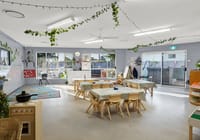
Hotel rooms get smaller as communal facilities become hot-ticket items for guests
The big news on hotel rooms is they’re getting smaller.
Once, customers loved to luxuriate in over-sized spaces but now size doesn’t matter so much; it’s more about what hotel companies do with what they’ve got.
“In the lifestyle sector in particular, as a result of the high cost of land, you’re seeing smaller room sizes, but balanced with good design,” says Simon McGrath, the chief operating officer of Australia’s biggest hotel group, AccorHotels, which pioneered small rooms from its mainstream Ibis brand to its newer Mama Shelter product.
The Australian market is now regularly seeing hotel rooms as compact as 18 square metres, but with guests having access to bigger bars, shared lounge rooms and lobbies that are actually designed to be used.
It’s a fundamental shift in an industry that traditionally saw big as better, particularly when Asian brands first entered the market, sometimes touting rooms as large as 40-50 square metres as ‘standard’.
“But now there’s a whole generation who prefer to have quality space rather than a big room, when they’re paying for a lot of ‘wasted’ space,” says Australian hotel industry consultant Peter Hook.
“The cost of land is now prohibitive for new-build hotels, so it’s mostly about conversions from other types of buildings, like Sydney’s Primus Hotel from the 1930s Sydney Water Board building, or the Tank Stream Hotel conversion, or using air space above buildings to add rooms like the Rydges Central Sydney at Surry Hills.
”But for many travellers, location is their priority, and they prefer a smaller room in a well-placed hotel, like the new Ibis Sydney King Street Wharf by Barangaroo, rather than a large room in an area that’s not so convenient.”
These hotels have often been ingenious in adding shared communal facilities to add value too, says Hook. That Ibis turned a very plain breakfast room into a funky lounge called Lot 51, where guests will even be able to program the music to match their mood.
New technology has saved space too, particularly with flat-screen TVs replacing the once-ubiquitous box-shaped TV inside a sliding-door cabinet. The trend towards minimalism has helped enormously.
“We are seeing wardrobes disappearing, replaced with a simple hanging space and even question marks over the need for a desk, especially for the leisure market,” says Simon Carmody, managing director of hotel interior designers Carmody Group, which now has over 50 hotel contracts to their name.
“Open-plan bathrooms that morph into the bedroom are now also favoured by designers, which is very effective in creating more space. Square metres can be cut out of guest rooms with furniture which is minimalist yet striking, bold and full of personality.
“Hotel booking engines are hungry for click bait that offer surprise.”
A great example of a hugely successful brand has been the citizenM Hotels, which began in Holland. Their rooms are often about 15 square metres but are of a funky design with huge quality beds taking up most of the space, and TVs on the wall opposite. They’re coupled with a communal floor of delis, bars and lounges for guests to have meetings, eat and meet friends.
AccorHotels’ Mama Shelter hotels, designed by Philippe Starck, are of a similar philosophy, with the communal spaces in its Los Angeles property including a rooftop bar. Last year AccorHotels also launched its fast-growing JO&JOE, a new lifestyle brand targeting millennial travellers with small, economic rooms and shared spaces, with the aim of having 50 venues by 2020.
“It’s about usable rooms with really good design elements, and big food and beverage spaces,” says McGrath. “That communal living concept is extremely popular with millennial travellers and those within the millennial halo. It’s in the new designs coming in that we’re now seeing this trend.”
Chief executive of Tourism Accommodation Australia Carol Giuseppi says smaller rooms and larger community spaces are coming in not only in the Sydney and Melbourne CBDs but also in Adelaide and Perth.
In Sydney there’s the new Mantra at Sydney Airport as well as the Tribe in Perth. There’s also the Holiday Inn Express in Macquarie Park, and its sister Holiday Inn Express in Adelaide.
“In resort areas, you’ll still see bigger rooms,” says Giuseppi. ”But in more corporate environments it’s now about more compact rooms that are well-designed and have good access to technology, as well as bigger common areas where you can have a meal or a drink and relax.”
Designers are now increasingly being asked to come up with good ideas for more functional condensed rooms. Dennis Clark, founder of Hotel Interiors, says it annoys him these days to have a large suite where he can never reach his phone, left charging in another room, before it stops ringing.
“With business travel in particular, you want everything within physical range and you don’t want to have to scrabble under desks for plugs,” he says. “It’s about convenience, while you also want everything you have at home, only better, like a bigger bed.”
The Alex in Perth, for instance, has created headlines with small room sizes but much more elaborate communal facilities, like rooms fitted with self-serve tables filled with food. Richard Misso of designers The Stylesmiths says he can see the influence of Airbnb accommodation platforms here in particular.
“Those communal areas mean people can connect with other people so it’s much more of an Airbnb experience in a hotel environment,” says Misso. “A lot of hotels are responding to the idea that people don’t just want to stay in a place; they want to live there, and have an area to eat and lounge around and have friends over. They want a home experience, but better.”














